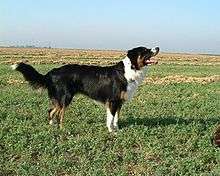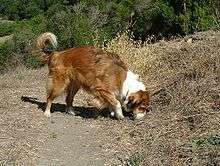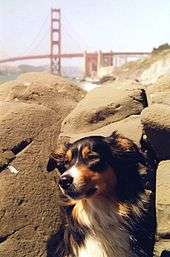English Shepherd dog
 Tricolor English Shepherd | ||||||||
| Other names | Farm collie | |||||||
|---|---|---|---|---|---|---|---|---|
| Origin | England | |||||||
| ||||||||
| Domestic dog (Canis lupus familiaris) | ||||||||
The English Shepherd is an extremely versatile breed of working dog of the collie lineage, developed in the United States from farm dogs brought by English and Scottish settlers in the 17th through 19th centuries before pedigrees became fashionable around the end of the 19th century. Subsistence farmers appreciated the breed for their versatility and not for their flash or strict conformation to a standard of appearance.
The English Shepherd is a highly intelligent, all-around farm dog, being used as a herding dog, livestock guardian, farm watch dog, hunting dog, vermin eradicator and a child's companion. English Shepherds were not bred to be specialized to work one type of livestock as some recent herding dogs have been. English Shepherds were bred to do many tasks on the small diversified farms of the 17th through early 20th centuries that had various types of livestock including cattle, sheep, pigs, goats, and fowl. It may have been the most common breed in America during the 19th and early 20th century.[1]
Description
Appearance
English Shepherds are similar in appearance to Border Collies and Australian Shepherds. English Shepherds usually have tails and a less rounded head than many Aussies. English Shepherds are never merle as Aussies frequently are. They are generally not square in body like an Aussie. English Shepherds tend to be larger than Border Collies but are most readily distinguished from Border Collies by their very different upright, loose-eyed herding style.
The English Shepherd is a medium-sized dog, usually somewhat longer than it is tall. It generally weighs between 20 to 30 kilograms (44 to 66 lb) and is balanced in proportions. As a working dog on small farms, English Shepherds have been selected to fulfill a variety of needs. This has resulted in a wide range of regional variations.
The coat is medium length and can be straight, wavy, or curly. There is frequently feathering on the legs and tail, as well as on the ear. As a working dog, the coat should be easy to keep, requiring very little grooming. Dirt tends to just fall away. English shepherds tend to shed quite a lot and fur may be found on and under furniture, clothes, and carpeting. The primary coat colors are: sable and white (clear and shaded), tricolor, black and white, and black and tan. Other variations such as solid dogs of any color, piebalds, and red nosed tricolors and sables also exist but are not common.
Temperament

The English Shepherd temperament is the defining characteristic of the breed, with high intelligence and often a unique type of kindness for those in his home, both animals and people. The English Shepherd is often an independent worker. English Shepherds are adaptable and learn routines quickly. Some can be watchful of strangers and are more one-person dogs. However, once he accepts people or children or stock as his own, there are few better caretakers than an English Shepherd.
The English Shepherd frequently exhibits an independent, bossy or "enforcer of the rules" streak in his temperament. If the dog's desire to enforce order is not channeled and directed to a suitable end by a strong, confident leader, he may exhibit many undesirable behaviors. Nevertheless, English shepherds can thrive as companion dogs in environments that provide sufficient mental and physical stimulation.
English Shepherds require a lot of exercise (at least 40 minutes of walking per day) and may become destructive if not provided enough. They have a natural instinct to chase and enjoy playing a game of fetch. They tend to become calm and relaxed at the end of the day, likely to curl up at their owner's feet.
This breed was selected on diverse small family farms in the past and has been selected to work in a partnership arrangement with his master.
Health
Because of their medium size and the fact that they have not been aggressively over-bred, English Shepherds are generally healthy dogs, typically avoiding problems (like hip dysplasia) that are more common in some other breeds. However, anyone contemplating getting an English Shepherd would be well advised to research the hip ratings (OFA or PennHIP) of the breeder's stock as with any other breed.
MDR1 gene mutation
Recent research at Washington State University indicates that, in addition to many other herding breeds, approximately 15% of the English Shepherd population is subject to the MDR1 gene mutation. Dogs that are tested positive have increased sensitivity and adverse reactions to a number of common canine drugs. A simple cheek swab is all that is needed to test if the dog has this potentially life-threatening condition.[2]
History
Originating in northern England and Scotland, these dogs came with the first settlers to reach the American colonies. American farmers appreciated this versatile breed and used dogs to protect their farms and livestock.[3] The English Shepherd and various other collies were also referred to as Scotch Collie's during the 18th and 19th centuries but the term "Scotch Collie" fell out of favor during the 20th century.[4] Quoting from Leon F. Whitney early in the 20th century ("How to Breed Dogs", 1937, no ISBN) "It is known variously as the farm shepherd, the barnyard collie, the old fashioned shepherd, the cow dog, the English Shepherd, and other colloquial names. And while I doubt there is a more alert, trustworthy, or American dog, still no breed specialty clubs have organized to push it. It is the ordinary shepherd that one sees on farm after farm throughout the country." (Despite the publication date of 1937 given here English Shepherds were registered as a breed before that time through UKC (1927[1]) and probably the defunct Southeastern Kennel Club before then.)
UKC apparently had another registration going on for a type of "farm shepherd" that was separate from the English Shepherd. Many times the names were confused but at other times they were distinguished as different breeds. All of these names as well as Farm Collie were applied to the farm shepherds of the era. As there was no breed club or registry until later, there is some dispute over exactly which name applies to which dogs. Australian Shepherd is likely a derivative of these farm dogs and appeared primarily in the Western United States. The English Shepherd on the other hand was more common in the Midwest and East.[5] These dogs are primarily descendants of the working farm dogs of England.
As the small diversified farms in the mid-western and eastern United States dwindled in numbers, many of them replaced by larger and less diversified operations, the English Shepherd became a rare breed.
Working life

English Shepherds are very quick to learn farm routines and will work independently with little training, but will benefit from some training and guidance. More than just a specialty herding breed, the English Shepherd is also a guardian of property and livestock, and a hunter of game and vermin on their territory. English Shepherds are also known for their ability to track and 'tree' raccoons and squirrels.
The modern English Shepherd is best suited for farm work, but they are used for hunting, search and rescue (SAR), therapy, and as competitors in dog agility, obedience, Rally obedience, tracking, and flyball.
English Shepherds are often larger than Border Collie, but the quickest way to tell the two apart is to put them on stock. Border Collies tend to herd with a distinctive strong eye contact and a crouching stance, while English Shepherds have an upright, loose-eyed herding style. English Shepherds can work all types of stock—from the meanest bull to baby chickens. Compared to others, they are prized above specialty herding breeds for being as gentle as possible or as tough as necessary with the stock.
This ability to rate their stock stems from the great empathy they have for their family and livestock. With the right upbringing, this empathy makes the English Shepherd a wonderful family dog. However, the same bossy nature which this breed excels at in keeping order on the farm can cause havoc in the local dog park where the English Shepherd often appoints himself as the leader.
Activities

English Shepherds can compete in dog agility trials, obedience, showmanship, flyball, tracking, and herding events. Herding instincts and trainability can be measured at noncompetitive herding tests. English Shepherds exhibiting basic herding instincts can be trained to compete in herding trials.[6] English Shepherds also possess a strong hunting instinct from their past use as an all purpose farm dog. They are known to tree prey and can be trained to flush birds by taking advantage of the innate herding instinct.
References
- 1 2
- ↑ http://www.vetmed.wsu.edu/depts-VCPL/breeds.aspx
- ↑ "English Shepherd History".
- ↑ A Celebration of the Working Collie, Cindy M. Dorsten c. 2002
- ↑ Linda Rorem (January 2010). "A View of Australian Shepherd History". Herding on the Web. Retrieved December 8, 2010.
- ↑ Hartnagle-Taylor, Jeanne Joy; Taylor, Ty (2010). Stockdog Savvy. Alpine Publications. ISBN 978-1-57779-106-5.
External links
| Wikimedia Commons has media related to English Shepherd. |
- ESC Breed & Breeder Info Website
- English Shepherd Club
- English Shepherd Club Registry
- The United Kennel Club, Inc
- United English Shepherd Association
- ESC breed standard
- National English Shepherd Rescue
- Rare Breeds Network